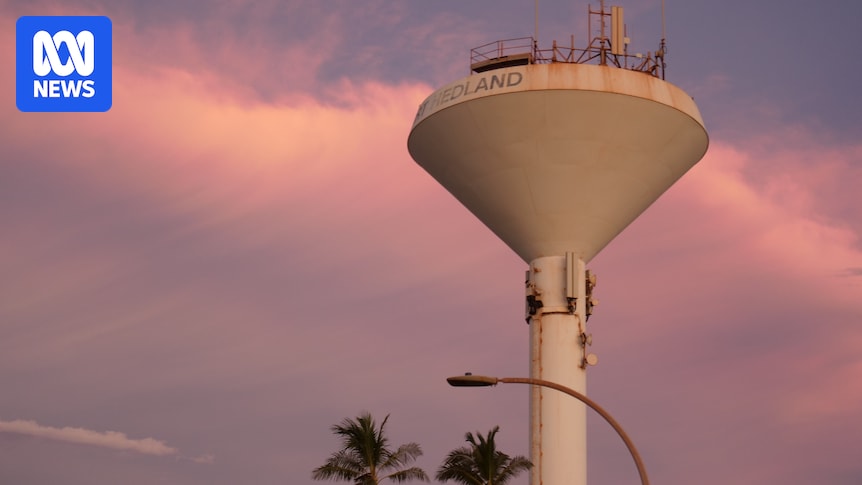Western Australia’s Water Corporation has walked back suggestions pressure on Port Hedland’s drinking water will halt major development in the Pilbara town.
The concerning warning was issued in a letter from the state-owned utility to the Town of Port Hedland, in which the corporation said a proposed 100-dwelling, 400-bed accommodation project could not be supported due to the town’s water supply being “at capacity”.
It said further major developments around the town, home to more than 15,000 people and the state’s major bulk export port, could not occur until more water was sourced.
But speaking to ABC Regional Drive on Friday, Water Corporation general manager of assets planning Evan Hambleton walked that advice back.
“Unfortunately, that was some incorrect advice that was provided and we’ve since spoken to the Town of Port Hedland and advised them that yes, that development can go ahead,” he said.
Port Hedland is a hub for resources in the Pilbara. (ABC News: Kimberley Putland)
“Ninety-nine per cent of the time it is perfect advice, this time unfortunately it was a bit wrong; there was a little bit of a miscommunication inside the organisation and the incorrect advice was given out.”
Mr Hambleton reassured Port Hedland residents the town’s water supply was also secure.
But he conceded it was under pressure.
“Port Hedland, like a lot of schemes, is under pressure from demand and climate change,” Mr Hambleton said.
“We are working to bolster those sources with new sources of water, and we are working with developers to ensure they can continue to develop, but they’re doing it in a manner that’s sustainable and doesn’t impact existing customers on the scheme.”
Port Hedland’s existing sources of water. (Supplied: Water Corporation)
Locals left out to dry
The letter, and earlier statements from the corporation, had indicated developments requiring more than 49,000 litres of water per day could not be supported.
The advice alarmed locals before it was retracted.
Pilbara Tourism Association chair Barry Harrison said it was disappointing for the town, which is already facing a shortage of accommodation.
“We desperately need more tourism accommodation here in Port Hedland and any lack of perceived water supply is obviously going to impact that and other major projects,” he said.
Barry Harrison says the town can’t grow without water. (ABC Pilbara: Alistair Bates)
“Water is the source of life and without that we can’t do anything, let alone building new accommodation, you know, new hotels, new accommodation for local people.
“If that’s what Water Corp is telling the council it’s quite disappointing that there’s not some plans in place or afoot. There should have been years ago to resolve this problem.”
Port Hedland’s drinking water is supplied from two groundwater bore fields, with allocation of the region’s scarce water resources already under public scrutiny this week.
Michael Thompson is a pastoralist at Mundabullangana Station, Port Hedland. (ABC News: Michelle Stanley)
Michael Thompson’s Mundabullangana Station is located above the the Yule River bore field, which is controlled by the Water Corporation.
The pastoralist told ABC Radio Perth this week he was drilling deeper and deeper to access water for his cattle on the station, once renowned for its water quality.
Alternative sources long away
Water levels in another dam near Karratha, 240 kilometres west, have dropped by 19.5 per cent this year.
While the Harding Dam, south of nearby Roebourne, sits at just 21.6 per cent capacity.
Harding Dam is one of Karratha’s water sources and has dropped by nearly 20 per cent from last year. (ABC News: Stephen Stockwell)
Water Corporation said declining inflows into Harding Dam were entirely climate driven, with no significant recharge since April 2022.
A spokesperson told the ABC it was investigating new drinking water sources, including the likely construction of a desalination plant.
But in the letter, it said the new source was not expected until the early 2030s, with capacity constraints to remain until then.
Speaking before the Water Corporation walked back its advice to the council, WA Nationals leader Shane Love said it was baffling the situation had been allowed to deteriorate by the Water Corporation and WA government.
Shane Love says it is a “disgrace” that Port Hedland’s water supply was allowed to reach capacity. (ABC News: Keane Bourke)
“I’m absolutely dumbfounded that in the town of Port Hedland … there has not been the far-sightedness to actually provide sufficient water for the growth of the town,” he said.
“It means that Port Hedland can’t grow. This is a disgraceful situation.”
However, in his interview with the ABC on Friday afternoon, Mr Hambleton said extensive planning and investigation was underway for a new long-term water source for Port Hedland, including a desalination plant, but it was a complex process.
“We are actively working on new sources, we’ve been fairly open that desalination is likely a new source option for Port Hedland but that takes some time,” he said.
“In the interim, we’re looking at some existing groundwater sources [and] some new groundwater sources to get us through that period until we have desalination online to support Port Hedland into the future.”

